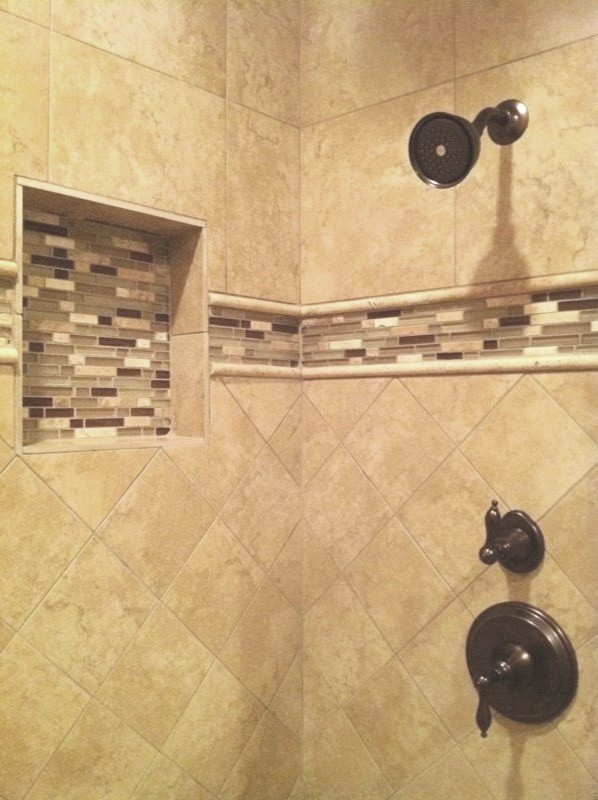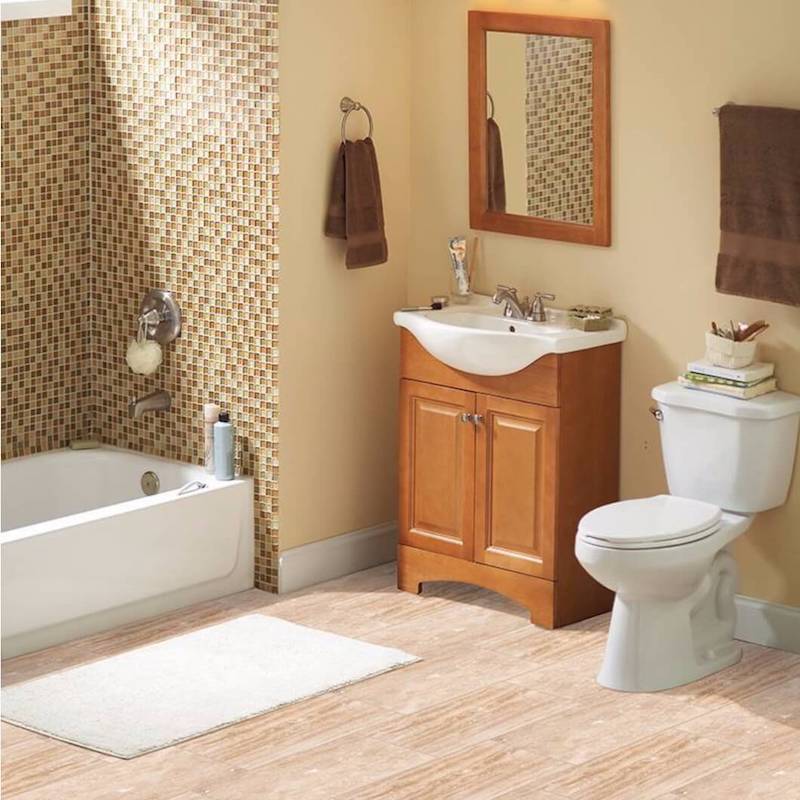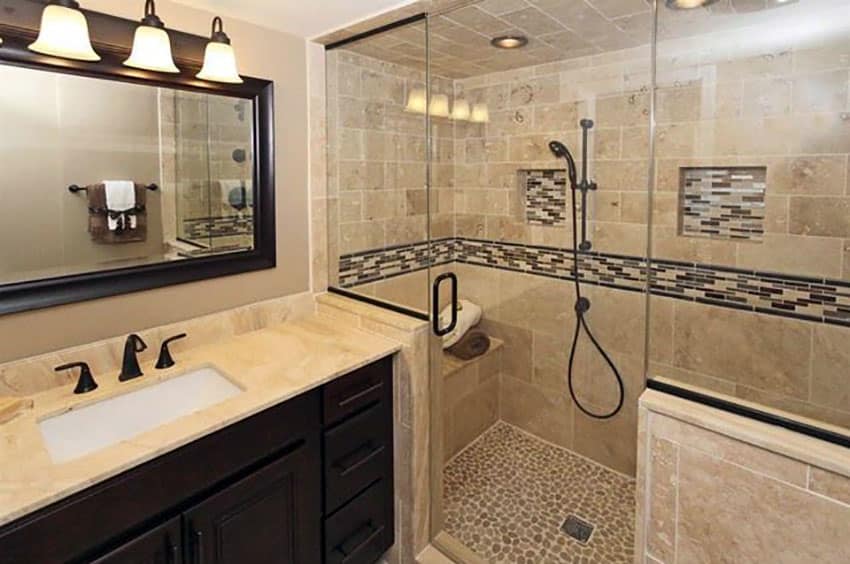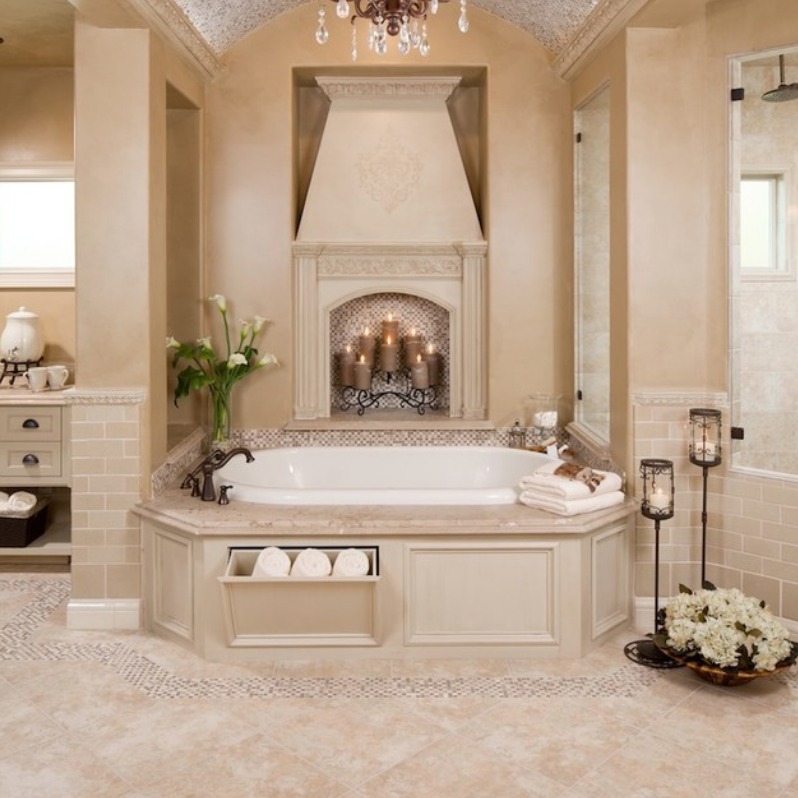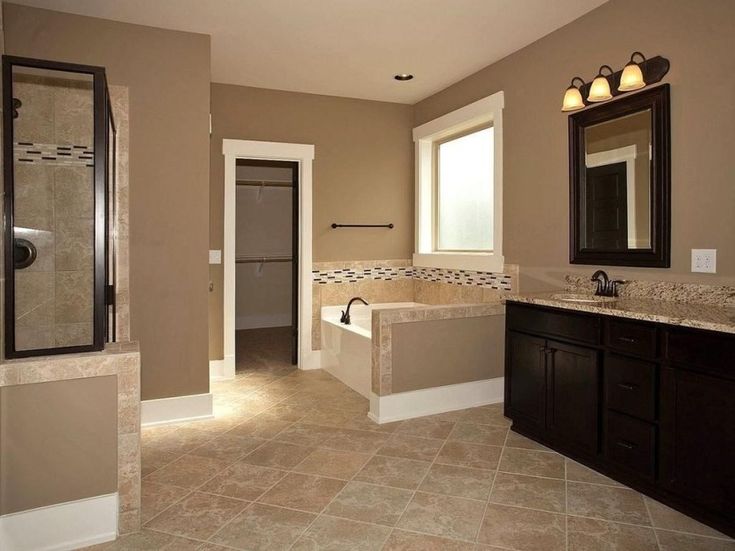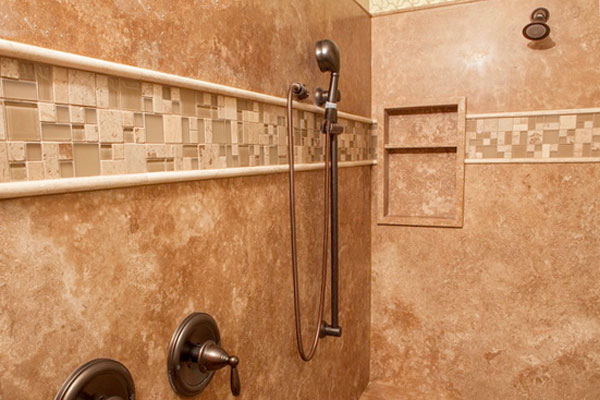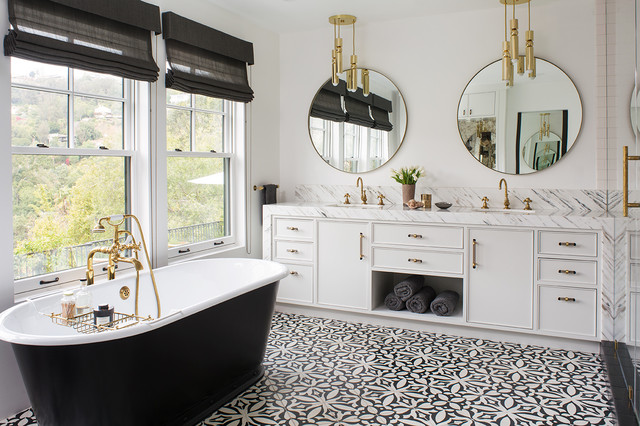Travertine: Understanding the Appeal of This Natural Stone
Travertine, a type of limestone, has been used in construction and design for thousands of years, dating back to ancient Roman times. This natural stone is prized for its unique textures, durability, and timeless beauty. Let’s discuss the characteristics that make travertine an appealing choice for bathroom tiles and why it is a popular material in modern interior design.
- Natural Beauty: Travertine’s natural beauty is one of its most significant appeals. The stone features a range of earthy tones, including cream, beige, brown, and gold, with subtle variations and natural veining that give each tile a unique look. This organic aesthetic can create a warm, inviting atmosphere in any bathroom, making it feel luxurious and serene.
- Versatility in Design: Travertine is incredibly versatile and can be used in various design styles, from classic and traditional to modern and contemporary. Its adaptability makes it an excellent choice for homeowners looking to achieve different aesthetics in their bathroom design. Whether you prefer a rustic, old-world charm or a sleek, modern look, travertine can be incorporated to enhance your vision.
- Durability and Longevity: As a natural stone, travertine is highly durable and can withstand the wear and tear of everyday use in a bathroom. When properly sealed and maintained, travertine tiles can last for decades, making them a cost-effective investment in the long run. Their moisture and humidity resistance also make them particularly suitable for bathroom environments.
- Unique Textures: Travertine comes in various finishes, including honed, polished, brushed, and tumbled, each offering a different texture and appearance. The honed finish provides a smooth, matte surface, while the polished finish gives a glossy, reflective look. Brushed and tumbled finishes add a more rustic, textured feel, enhancing the stone’s natural character and slip resistance, ideal for bathroom floors.
- Eco-Friendly Choice: Using travertine tiles can be an eco-friendly choice for your bathroom design. As a natural material, it has a lower environmental impact than synthetic alternatives. Additionally, the production and quarrying processes for travertine tend to be less energy-intensive, reducing its overall carbon footprint.
- Timeless Appeal: Travertine’s timeless appeal ensures that it never goes out of style. Its classic beauty and natural elegance can enhance any bathroom, regardless of changing design trends. By choosing travertine, you’re investing in a material that will retain its aesthetic value and continue to impress for years to come.

Classic Designs: Timeless Travertine Tile Patterns for Your Bathroom
Travertine tiles are renowned for their classic appeal and versatility. Their timeless beauty can be showcased in various traditional patterns that have stood the test of time. Below are several classic travertine tile patterns that can add a touch of elegance and sophistication to your bathroom.
Herringbone Pattern: The herringbone pattern is a classic choice that brings a sense of movement and sophistication to any bathroom. This pattern involves arranging rectangular travertine tiles in a zigzag formation, creating a dynamic and visually appealing design. The herringbone pattern works well for both floors and walls, adding texture and interest to the space.
Subway Tile Layout: The subway tile layout is another timeless pattern that remains popular in bathroom design. This involves laying rectangular tiles in a staggered brick-like fashion. Using travertine in a subway tile layout combines traditional elegance with a modern twist, making it suitable for various bathroom styles. The natural veining of travertine adds depth and character to this classic pattern.
Basket Weave Pattern: The basket weave pattern is a sophisticated choice that involves interlocking tiles to create a woven appearance. This pattern typically uses smaller tiles, making it ideal for shower floors or backsplashes. The basket weave pattern showcases travertine’s natural beauty and adds a touch of luxury to the bathroom. It’s a perfect way to introduce a subtle yet intricate design element.
Versailles Pattern: The Versailles pattern, also known as the French pattern, is a classic and elegant layout that combines tiles of different sizes to create a unique, repeating design. This pattern is perfect for large bathroom floors and adds a sense of grandeur and sophistication. The Versailles pattern highlights the natural variation in travertine tiles, enhancing their rustic charm.
Diagonal Pattern: Laying travertine tiles diagonally can create a sense of space and movement in a bathroom. This pattern involves setting tiles at a 45-degree angle to the walls, which can make the room appear larger and more dynamic. The diagonal pattern is a great way to showcase the natural veining and color variations of travertine, adding visual interest to both floors and walls.
Chevron Pattern: The chevron pattern is similar to the herringbone but with a more streamlined, continuous design. In this pattern, tiles are cut at an angle and arranged to create a continuous zigzag line. The chevron pattern adds a modern twist to traditional travertine tiles, making it a versatile choice for various bathroom styles. This pattern can be used on floors, walls, or even as a striking shower feature.
Innovative Ways to Use Travertine in Contemporary Bathrooms
While travertine is often associated with classic and traditional designs, it can also be used in innovative ways to create contemporary bathroom spaces. This natural stone’s versatility allows it to be incorporated into modern aesthetics, bringing warmth and texture to sleek, minimalist designs. Let’s see some creative and contemporary uses of travertine in bathroom design.
Large Format Tiles: Using large format travertine tiles can create a modern, streamlined look in your bathroom. These oversized tiles reduce the number of grout lines, resulting in a clean and seamless appearance. Large format tiles are ideal for both walls and floors, providing a contemporary backdrop that highlights travertine’s natural beauty and veining.
Mixed Material Designs: Combining travertine with other materials can add a modern twist to your bathroom. Pairing travertine with materials like glass, metal, or concrete can create a unique and stylish contrast. For example, a travertine feature wall with glass accents or a travertine floor with concrete countertops can bring a fresh and contemporary feel to the space.
Minimalist Aesthetic: Travertine can be used to achieve a minimalist aesthetic by focusing on simplicity and clean lines. Opt for honed or polished travertine tiles with a smooth, matte finish to create a sleek and modern look. Keep the design uncluttered with minimal accessories and neutral color palettes to let the natural beauty of the travertine shine.
Floating Vanities and Sinks: Incorporating travertine into floating vanities and sinks can add a touch of luxury to a modern bathroom. A floating vanity with a travertine countertop or a vessel sink made from travertine can serve as a striking focal point. The combination of natural stone and contemporary design elements creates a sophisticated and stylish look.
Accent Walls: Creating an accent wall with travertine tiles can add texture and visual interest to a contemporary bathroom. Choose a wall that serves as a focal point, such as behind the vanity or in the shower area. Use travertine tiles in a unique pattern or layout to draw attention and enhance the overall design. An accent wall can create a dramatic and modern statement in your bathroom.
Backlit Travertine: Backlighting travertine tiles can create a stunning and contemporary effect. The natural translucency of travertine allows light to pass through, highlighting its unique veining and patterns. Use backlit travertine in areas like shower walls, vanity backsplashes, or even as a decorative feature. This technique adds a modern and luxurious touch, creating a warm and inviting ambiance.
Exploring the Diverse Hues of Travertine Tiles
Travertine tiles come in a wide range of colors, each offering a unique look and feel for your bathroom. From warm, earthy tones to cool, neutral shades, the diverse hues of travertine can complement various design styles. Let’s discuss the different color variations of travertine tiles and how to choose the right hue for your bathroom.
Classic Beige and Cream: Beige and cream are the most common and classic colors for travertine tiles. These warm, neutral tones create a timeless and elegant look that works well in traditional and modern bathrooms alike. Beige and cream travertine tiles can add a sense of warmth and comfort to your bathroom, making it feel inviting and cozy.
Warm Gold and Brown: Travertine tiles in gold and brown hues bring a rich and luxurious feel to your bathroom. These colors highlight the natural veining and texture of the stone, adding depth and character. Gold and brown travertine tiles work well in rustic, Mediterranean, or classic design styles, creating a warm and opulent atmosphere.
Cool Gray and Silver: Gray and silver travertine tiles offer a more contemporary and sophisticated look. These cooler tones can create a sleek and modern bathroom, providing a neutral backdrop that pairs well with various colors and materials. Gray and silver travertine tiles are perfect for minimalist designs, adding a touch of elegance without overwhelming the space.
Rich Walnut and Chocolate: Walnut and chocolate-colored travertine tiles bring a deep, rich hue that can add a sense of luxury and sophistication to your bathroom. These darker tones create a dramatic effect and work well in larger bathrooms or as accent features. Walnut and chocolate travertine tiles can be paired with lighter colors and materials to create a balanced and stylish look.
Subtle Ivory and White: Ivory and white travertine tiles offer a clean and fresh look, making your bathroom feel bright and airy. These lighter hues are perfect for small bathrooms, as they can make the space appear larger and more open. Ivory and white travertine tiles work well in modern, minimalist, and classic designs, adding a touch of elegance and simplicity.
Unique Multicolor and Veined: Travertine tiles with unique multicolor patterns and pronounced veining can create a striking and artistic look in your bathroom. These tiles showcase the natural beauty and variation of travertine, making each piece a work of art. Multicolor and veined travertine tiles can be used as focal points or accent features, adding visual interest and character to your bathroom.
Pairing Travertine with Other Bathroom Elements
Pairing travertine with other materials can enhance your bathroom’s overall design and create a unique and cohesive look. Combining different textures, colors, and finishes can add depth and interest to your space. Let’s discuss various ways to pair travertine with other bathroom elements to achieve a harmonious and stylish design.
Glass and Travertine: Combining travertine with glass can create a beautiful contrast of textures. Use glass tiles as accents or borders to complement travertine walls or floors. A glass shower enclosure paired with travertine tiles can create a clean and modern look, while the reflective quality of glass enhances the natural beauty of the stone. This combination is perfect for creating a light and airy bathroom design.
Wood and Travertine: Wood and travertine together can bring a warm and natural feel to your bathroom. Pair travertine tiles with wooden cabinetry, shelving, or accents to create a rustic, earthy look. The combination of these natural materials adds texture and depth, making your bathroom feel cozy and inviting. Choose wood finishes that complement the color tones of your travertine for a cohesive design.
Metal and Travertine: Incorporating metal elements with travertine can add a touch of modernity and sophistication to your bathroom. Use metal fixtures, such as faucets, showerheads, and towel bars, in finishes like chrome, brushed nickel, or brass. Metal accents can provide a sleek and polished contrast to the natural stone, enhancing the overall aesthetic. Consider adding metallic mosaics or inlays to travertine tiles for a unique and luxurious touch.
Concrete and Travertine: Pairing travertine with concrete can create a contemporary and industrial look. Use concrete countertops, sinks, or flooring alongside travertine tiles to achieve a modern and edgy design. The combination of smooth, sleek concrete with the textured, natural look of travertine adds visual interest and balance. This pairing is ideal for those seeking a minimalist and stylish bathroom.
Ceramic and Travertine: Ceramic tiles can be used alongside travertine to add color and pattern to your bathroom. Use ceramic tiles as a backsplash, border, or accent wall to complement travertine floors or shower walls. The versatility of ceramic tiles allows you to play with different colors and designs, creating a personalized and unique look. Ensure that the ceramic tiles harmonize with the travertine’s color palette for a cohesive design.
Natural Stone and Travertine: Combining travertine with other natural stones, such as marble, granite, or slate, can create a luxurious and varied bathroom design. Use different stones for different areas, such as travertine on the floor and marble on the countertops, to add contrast and sophistication. The natural variations in color and texture of each stone will enhance the overall aesthetic, creating a rich and elegant space.
Travertine Accent Tiles
Travertine shower, Travertine Tile
Natural Travertine Bathroom Floors Redefine Luxury
Is Travertine Good For Bathrooms and Showers?
Travertine Shower Ideas (Bathroom Designs) – Designing Idea
Travertine Border Tile
Natural Travertine Bathroom Floors Redefine Luxury
Related Posts:
- Bathroom Tile Ideas Marble
- Bathroom Tile Brands
- Bathroom Tile Decals Transfers
- How To Clean Grout Between Bathroom Tiles
- How To Replace Grout In Bathroom Tile
- Bathroom Tile Design Ideas
- How To Paint Bathroom Tile And Tub
- Sealing Bathroom Tiles And Grout
- Classic Bathroom Tiles Ideas
- Bathroom Tile Cleaner Vinegar




